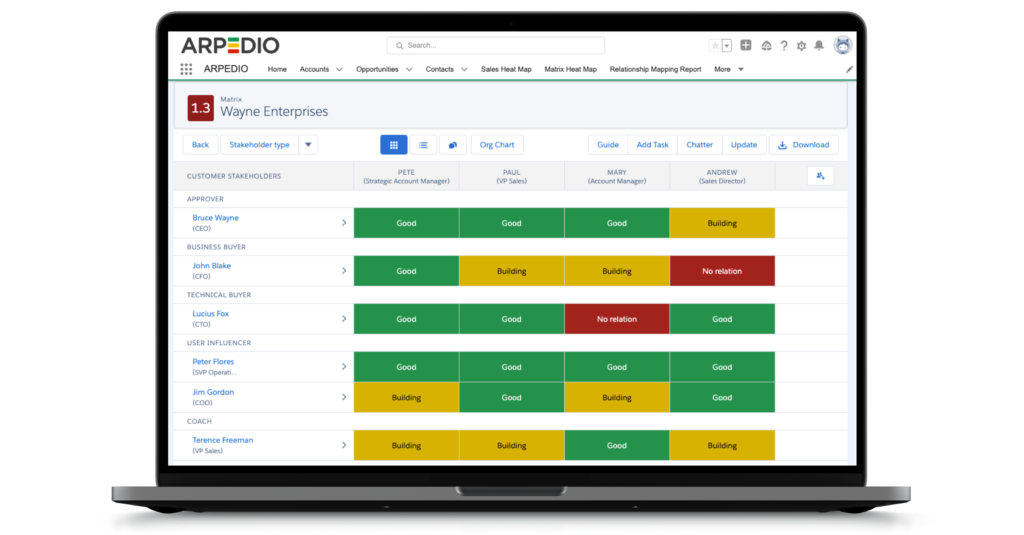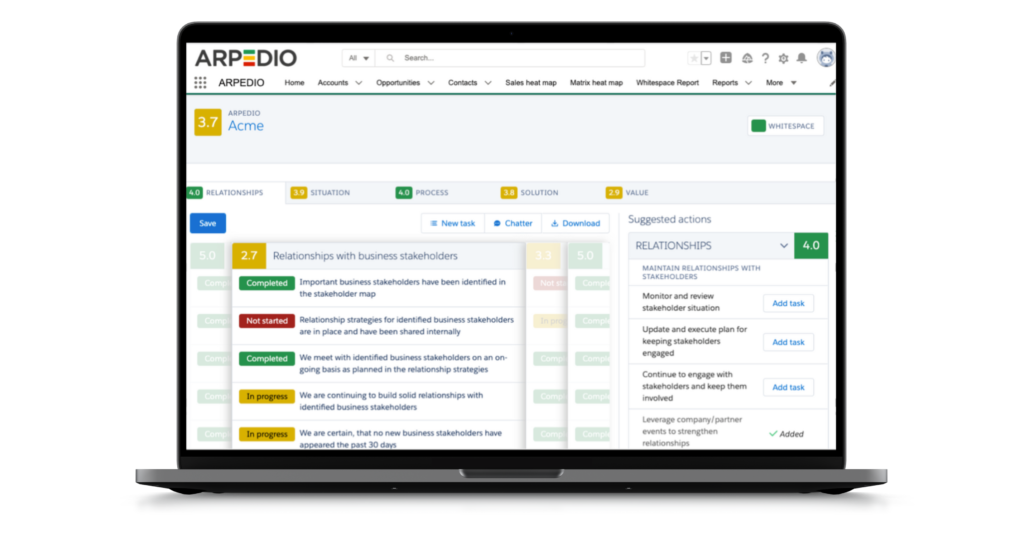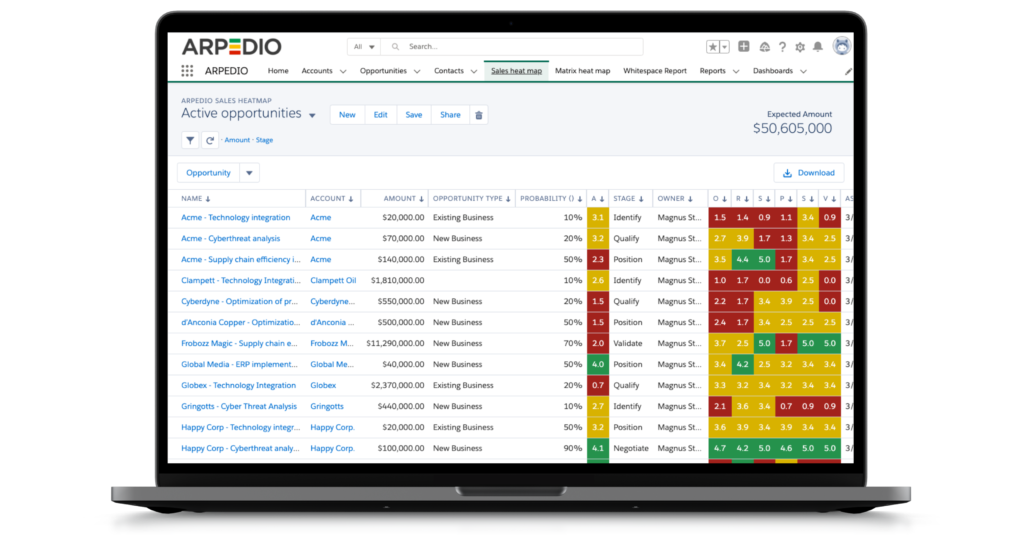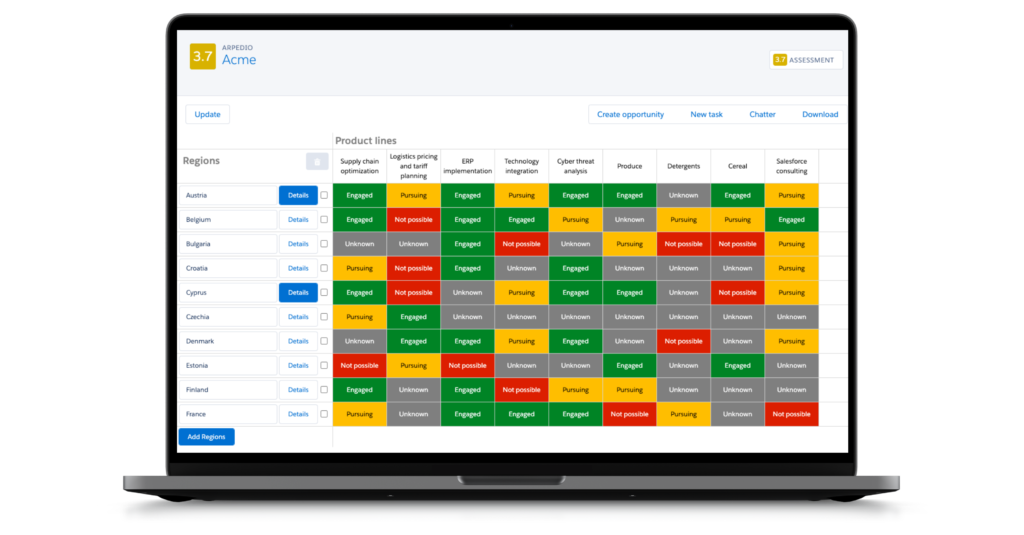Another year is coming to an end, and what a great opportunity to reflect on the year that’s (almost) passed and look ahead to the new one. On December 14th, we held our final LinkedIn Live of the year in the Digital Sales Revolutions series. We were fortunate to have three very competent sales professionals join us and share their key takeaways from the SAMA community 2021, and which trends to look for in 2022. In the following, we’ll touch upon key SAM/KAM learnings, what to focus on in the year to come, and last but not least, Harvey, Chris and Ned will share their best recommendations for today’s KAM leaders.
Key takeaways
- The virtual environment is here to stay – turn this challenge into an opportunity
- Virtual Interactions with customers put KAMs to the test – being better prepared and to the point is inevitable
- Really understand your customer’s challenges in order to provide valuable solutions
- Sales tools will give you a head start into 2022
- Account Based Marketing (ABM) increases in popularity
A brief introduction to the panelists
Ned Gilbert, Senior Director of Strategic Accounts for applied sciences team at Premier Inc. Ned has over 12 years of professional sales experience, 10 of which he has spent in healthcare sales, strategic account management and sales leadership working for Medtronic, the largest medical device company in the world.
Chris Jensen, Director of Customer Solutions at Strategic Account Management Association (SAMA) helping clients and members grow important relationships and becoming essential to customers for the past five years. Chris has previously worked 40+ years for DHL, latest as Global Sales Director.
Harvey Dunham, Director of Strategy & Marketing at Strategic Account Management Association (SAMA) has extensive experience in sales. He currently manages the overall relationship with SAMA’s most strategic accounts, and supports clients and corporate members to flourish in today’s rapidly changing business environment. He previously worked 35 years at Schneider Electric, where he started as Sales Engineer and finished as Global Solution VP.
Why SAMA?
The Strategic Account Management Association (SAMA) was founded back in 1964 by a number of chemical companies in the US. The CEOs of these large companies were failing to take proper care of their strategic customers, why they decided to create a special ‘force’ of salespeople to deal with the companies’ largest and most important customers. This became the strategic account management association, whose main purpose is to help members and customers become essential and trusted advisors to their customers. All together, SAMA has around 15.000 members in their community–everyone focused on SAM best practices, spreading this knowledge throughout the SAMA community, and ultimately enabling SAMs to do their jobs (even) better.
2021 Review & Highlights: A year of obstruction
Many of us probably thought, or at least hoped, that Covid would be a thing of the past by now, but that unfortunately isn’t the case. Covid and all the restrictions – and thus challenges – that have come with it are still very much present and something we must take into account in most things we do. Also when it comes to doing business.
Luckily, Premier Inc. as a whole didn’t suffer as many others, but actually managed to grow despite of Covid. When reflecting on the year that’s passed, Ned’s convinced that their ability to uncover what their customer’s needs were during this time of challenge, as well as being able to differentiate themselves from the competition, were two key factors for Premier coming out strong this year:
Ned does, however, point out that the importance of these virtual interactions you have with your clients has increased. Often, you will only have 30 minutes to an hour to make an impact on clients, and sometimes it’s even the first time you meet these people, so you really need to be on top of your game and make it count. In relation to this, Ned emphasizes that the ability to be nimble and make the most of the little time you have with your clients will get you a long way. And he’s positive that the people who succeeded with this were both authentic and genuine in their interaction and communication with clients, and most importantly really sought to understand their clients better than they understood themselves. Finally, “Using a number of different tools to really help with that and accelerate that were really some of the key highlights of 2021”, Ned concludes.
Harvey agrees that 2021 definitely has been nothing like anticipated. It’s been the year with the most disruption, according to Harvey: “It was Covid, it was the supply chain issues, there was a lot of digitalization and digital disruption that took place, and obviously a lot of political unrest. There’s so much going on and it’s been hard to focus.” In addition to this, Harvey points out that we’ve worked our entire lives learning how to present ourselves in person and how to read people’s body language and understand their environment and circumstances. Then in the blink of an eye, all of this was taken away from us. We had to hit the reset button and learn how to do it in a different way – and not only learning, but also getting really good at this new way of doing things, where being more concise and more to the point is inevitable. What Harvey has seen throughout this year in the SAMA community was that the great SAMs persevered and were able to adapt to this new reality. And seeing customers actually taking advantage of the current situation and improving their businesses for the better is undeniably a highlight of the year, Harvey says.
2021 also didn’t turn out to be anything like Chris expected. He’d prepared for a very slow year due to the whole Covid-situation. But luckily, he says, he was completely wrong: “It started like a faucet in January, and it never shut off.” Chris shares that they had the busiest year in his five years at SAMA with constant conversions of new memberships, and there’s no doubt in his mind that this shows that organizations have (finally) realized the importance of the SAM role, and how their ability to deliver during a time of crisis is crucial. Seeing businesses coming to terms with this has definitely been a big highlight for Chris this year. In a time of need, the SAMs have come through and proven their value, and Harvey seconds this:
Biggest challenges that SAMs faced in 2021 and key takeaways relative to these challenges
With the pandemic continuing to influence our everyday lives, there’s no getting around that the biggest challenge we faced in 2021 was (still) having to navigate in a virtual environment.
Sales directors and sales managers that drive large customers are used to being in front of people and connecting with them over meetings, dinners, etc. However, Covid put a stop to that, and the inability to meet people in the physical world, as well as transitioning collaboratives, councils and discussions from live to virtual environments, Ned highlights as the biggest challenge.
However, according to Ned, this isn’t necessarily all bad. This new virtual reality has also brought more flexibility. It has allowed us to connect with stakeholders that we may not have gotten face-to-face time with before. Some of the best doctors in the US and in the world might not have been able to travel to Premier’s offices in Charlotte, but now it’s possible to tap into those resources in a virtual environment and get those insights where you may not have gotten those insights or stakeholders previously. So, the challenges surrounding our new virtual reality have indeed also presented some new opportunities – ones that Premier was able to take advantage of. This did, however, also require a lot more effort from the salespeople, Ned says. KAMs must be (even) more prepared than before, and understand clients better than they understand themselves.
Prepared and to the point
Harvey agrees that having to do your job virtually was no doubt the biggest challenge this year. And when the supply chain issues really started to emerge around the second quarter of this year, SAM’s were again put to the test, as customer demands increased.
More than ever, SAMs and KAMs have to be concise. They have to get to the point, and they have to get there fast, Harvey says. Often, a 30-minute meeting is only 20 minutes by the time everyone gets introduced to one another and gets their technologies worked out etc. The same goes for the one hour meetings – if you’re lucky, you’ll have 50 minutes to actually get down to business. And sometimes a customer will even get on a 45-minute meeting and say they’re only able to stay for the first 20 minutes and so on. Just like that, SAMs are forced to be better prepared, to really think through and document the key points they want to make and get right to it. But, if you are able to do this well, you might turn disruption into opportunities:
To the point about connecting with the doctors that you couldn’t normally get time with, Harvey echoes that given the current circumstances, they might give you five minutes. And if you’ve got the right questions prepared, they can give you a great answer in a short period of time. So preparation is really important, as well as learning how to express yourself briefly and clearly.
Securing alignment in a disruptive environment
Creating internal alignment is what Chris finds has been the most challenging this year: “If you can imagine trying to create this internal alignment in a virtual environment in a crisis mode with your customer on production or quality or any of these issues, it’s not the same as when you’re sitting in the room together”. Keeping track of all these many different stakeholders has definitely been a big struggle, Chris continues, and he doesn’t think that we’ll see the end of this virtual environment any time soon. However, he’s sure that SAMs will continue to find ways to show new ideas and initiatives around internal alignment to make sure everybody’s pulling together in the same direction.
Key trends for for SAMs and KAMs in 2022, and how technology can support this
2022 presents a unique opportunity to reflect on what we’ve learned from 2021, and more importantly to take some time to really plan for what you’re looking to accomplish early in the next year:
And a big help for this is to include technology, Ned continues. He explains that as Premier has various very large customers across the globe with lots of different business units, they saw an opportunity in bringing in resources like ARPEDIO. Their ability to use technology and understand their clients and map those out has really been a game changer, Ned says. And to establish where you have really good relationships, where you can leverage your past proven value within those relationships to matriculate across the organization, those are the types of things that you have the time to do now as we enter the new year.
Ned says that the resources they have now thanks to ARPEDIO’s relationship mapping software, has provided them with the ability to get answers and understand organizations better and faster:
Harvey agrees that it will be worthwhile planning your time and using technology to support your business as we enter 2022. He’s worried that we’re all experiencing zoom fatigue, and also as the opportunity to travel opens up more, it will put more demand on the individual. It’s a long race, he says, and it should always be the first priority to maintain work-life balance. That’s why it’s absolutely key to plan your time and use the tools that you’ve got to make your work easier.
Introducing Account Based Marketing (ABM)
What Chris predicts for 2022 is that we’ll see a lot more of Account Based Marketing to support the SAMs. ABM has been more prevalent in the discussions than previously, Chris says, and they’re experiencing a lot of interest in this topic in the SAMA community. ABM as a business strategy focuses resources on a set of target accounts within a market. Via personalized campaigns designed to engage specific accounts, you are potentially able to tap right into conversations with prospects.
Another thing Chris mentions as an interesting idea for 2022 is having the contracting portion of the SAM work formalized with a customer-facing person that might come out of legal or risk that is specifically assigned to handle this. This could potentially be a game changer, as it would really take the ‘contracting headache’ out of that relationship between the SAM and the customer. This is definitely interesting, and something Chris would urge businesses to look into in the year to come.
All in all, Chris has high hopes and expectations for 2022; More live events will be happening, SAMA’s training will get back to in person, and we should all start to feel the community again – in person, which he’s sure will be beneficial to the SAMs.
Best recommendations for KAM leaders
Ned suggests that taking the time to really understand your customer and their challenges is the best recommendation for any key account manager. This will allow you to uniquely position your offerings, to stand out, and provide valuable solutions. But, this is not easy. It requires hours of preparation to really understand your clients well ahead of time. However, if you are looking to really make an impact, go wide and deep and concentrate on two to three clients to start. And finally, don’t forget to measure yourself against what your goals are, and what your clients’ goals are early on in 2022, Ned says.
Harvey’s best advice for KAM leaders in 2022 is very simple; start with the individual and a couple of questions about how they’re doing. You should first and foremost take the time to understand who they are as people; show interest and compassion with your customers, really with everyone that’s in your ecosystem, because we’re all dealing with a lot during these new circumstances, and this will only continue in 2022:
Last but not least, Chris emphasizes that leaders should take all the knowledge and learnings from ‘20 and ‘21 and walk in the shoes of their SAM teams. Leaders must above all else understand what’s going on with the customers as well as the challenges the SAMs are having: “Help those SAMs with those internal alignment issues, because you are on the front line of that, and you have to make that easier for the SAM and your customer. If you don’t do that, you’re not doing your job as a leader,” Chris finishes.
With those words, we’ll wrap up the final blog post of the year. We wish you all a merry Christmas and a happy New Year!
Watch or re-watch our LinkedIn Live on ‘2021 highlights and what to expect for 2022’ below:
Strengthen your SAM program with sales tools that will take your account planning and relationship mapping to the next level! You’ll be able to capture and visualize your critical customer data directly in Salesforce, making it accessible to everyone in real time.

Ulrik Monberg, CEO & Founder
+45 31 46 31 56 / +1 650 398 1285
um@arpedio.com
Linkedin.com/in/monberg
Follow us on LinkedIn to get all the newest perspectives and insights around strategic relationship management and sales innovation.

Ulrik Monberg, CEO & Founder
+45 31 46 31 56 / +1 650 398 1285
um@arpedio.com
linkedin.com/in/monberg
Follow us on LinkedIn to get all the newest perspectives and insights around strategic relationship management and sales innovation.
#1 Account-Based Selling Platform
Powerful alone. Superior together.
Boost win rates and reduce sales cycles. Enhance forecast accuracy.









